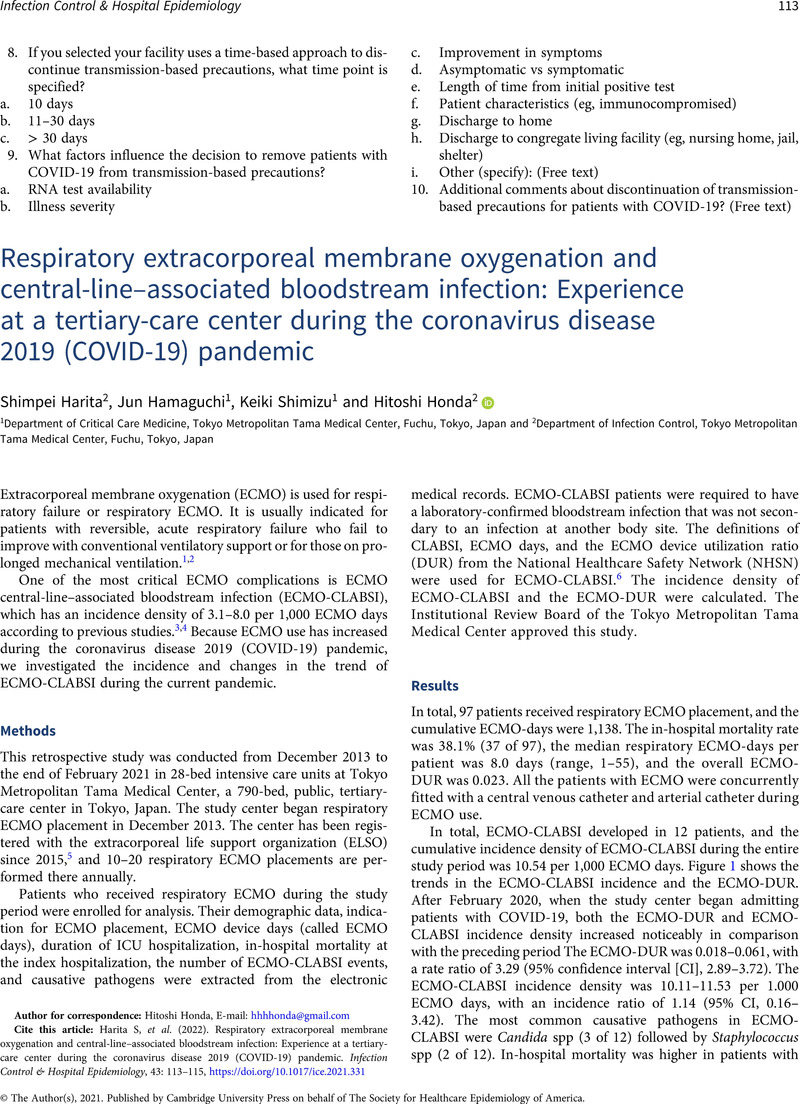No CrossRef data available.
Article contents
Respiratory extracorporeal membrane oxygenation and central-line–associated bloodstream infection: Experience at a tertiary-care center during the coronavirus disease 2019 (COVID-19) pandemic
Published online by Cambridge University Press: 02 August 2021
Abstract
An abstract is not available for this content so a preview has been provided. Please use the Get access link above for information on how to access this content.

- Type
- Research Brief
- Information
- Copyright
- © The Author(s), 2021. Published by Cambridge University Press on behalf of The Society for Healthcare Epidemiology of America
References
General guidelines for all ECLS cases. Extracorporeal Life Support Corporation (ELSO) webisite. https://www.elso.org/Portals/0/ELSO%20Guidelines%20General%20All%20ECLS%20Version%201_4.pdf. Published August 2017, Accessed April 14, 2021.Google Scholar
Na, SJ, Chung, CR, Choi, HJ, et al. Bloodstream infection in patients on venovenous extracorporeal membrane oxygenation for respiratory failure. Infect Control Hosp Epidemiol 2018;39:871–874.CrossRefGoogle ScholarPubMed
Seidelman, JL, Lewis, SS, Huslage, K, et al. To be a CLABSI or not to be a CLABSI—that is the question: the epidemiology of BSI in a large ECMO population. Infect Control Hosp Epidemiol 2018;39:362–365.CrossRefGoogle ScholarPubMed
Menaker, J, Galvagno, S, Rabinowitz, R, et al. Epidemiology of blood stream infection in adult extracorporeal membrane oxygenation patients: a cohort study. Heart Lung 2019;48:236–239.CrossRefGoogle ScholarPubMed
Center registry. Extracorporeal Life Support Corporation (ELSO) website. https://www.elso.org/Membership/CenterDirectory.aspx. Accessed April 14, 2021.Google Scholar
National Healthcare Safety Network (NHSN). Bloodstream infection event (central-line–associated bloodstream infection and non–central-line–associated bloodstream infection). Centers for Disease Control and Prevention website. https://www.cdc.gov/nhsn/pdfs/pscmanual/4psc_clabscurrent.pdf. Accessed April 14, 2021.Google Scholar
Fakih, MG, Bufalino, A, Sturm, L, et al. Coronavirus disease 2019 (COVID-19) pandemic, central-line–associated bloodstream infection (CLABSI), and catheter-associated urinary tract infection (CAUTI): the urgent need to refocus on hardwiring prevention efforts. Infect Control Hosp Epidemiol 2021. doi: 10.1017/ice.2021.70.CrossRefGoogle ScholarPubMed
Patel, PR, Weiner-Lastinger, LM, Dudeck, MA, et al. Impact of COVID-19 pandemic on central-line–associated bloodstream infections during the early months of 2020, National Healthcare Safety Network. Infect Control Hosp Epidemiol 2021. doi: 10.1017/ice.2021.108.CrossRefGoogle ScholarPubMed
Marschall, J, Mermel, LA, Classen, D, et al. Strategies to prevent central-line–associated bloodstream infections in acute-care hospitals. Infect Control Hosp Epidemiol 2008;29 suppl 1:S22–S30.CrossRefGoogle ScholarPubMed


